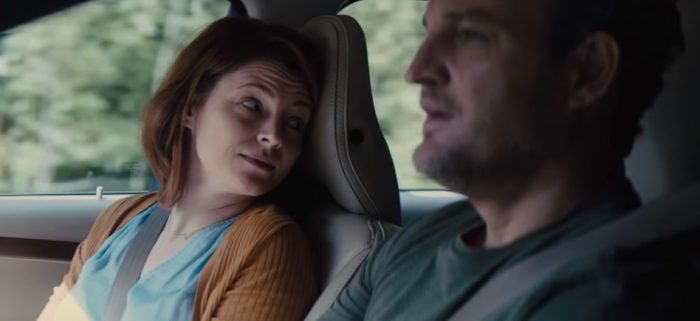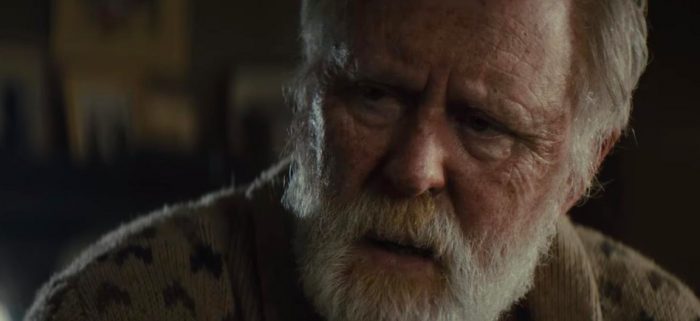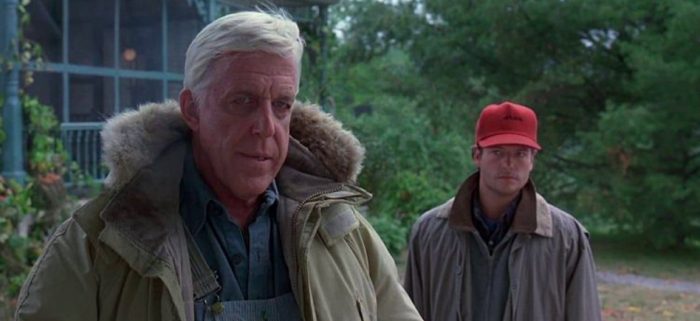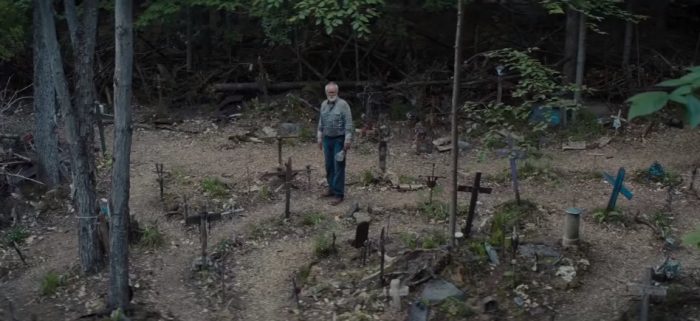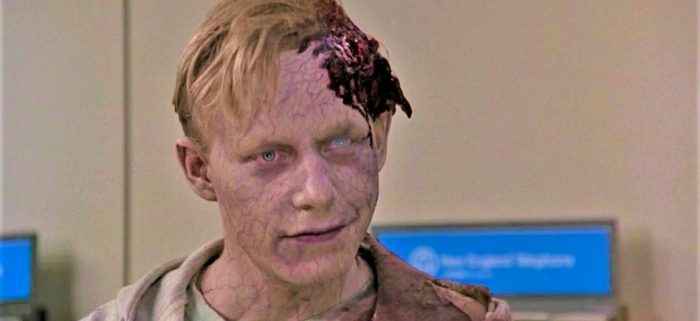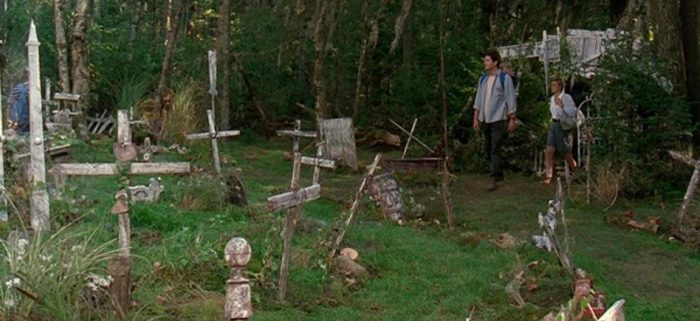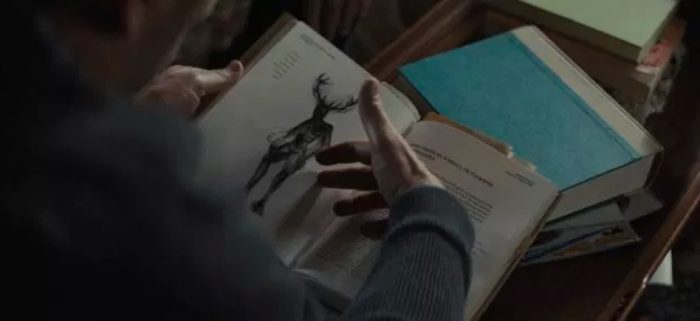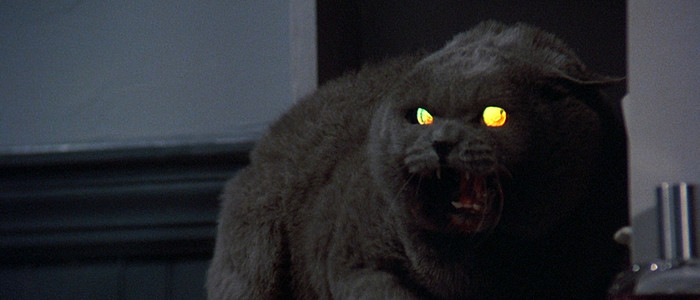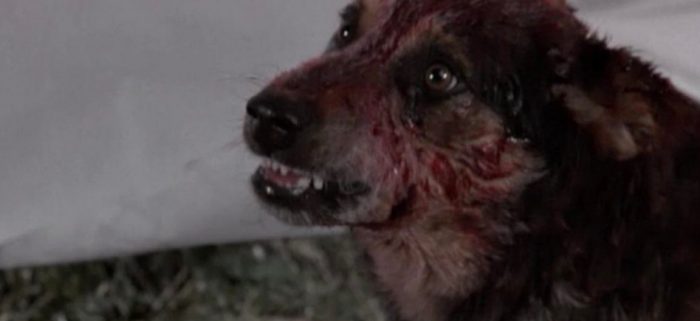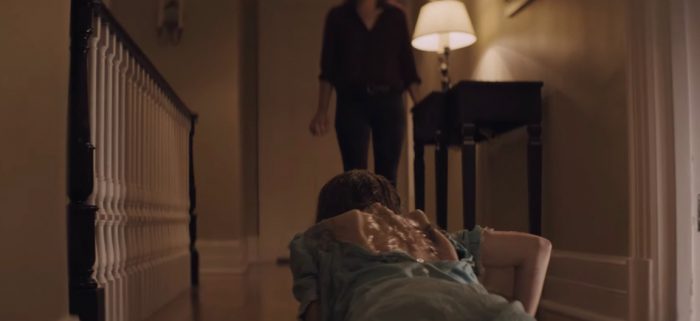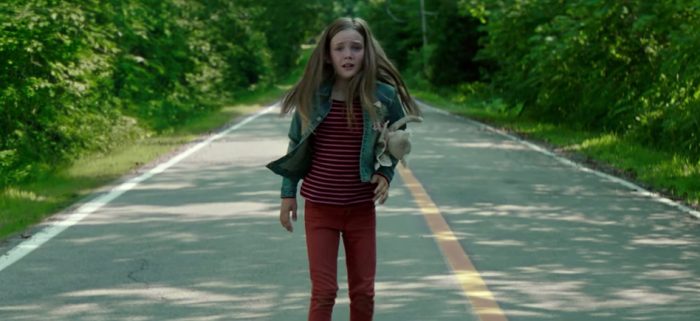'Pet Sematary' Book Vs. Film Vs. Film: Comparing Stephen King's Novel With Its Two Film Adaptations
In 1983, Stephen King released Pet Sematary, a novel so unsettling that even King himself felt he had gone too far. Decades later, it holds up as one of the author's best, and scariest, books. Hollywood has turned to King's novel about a cursed burial ground twice now (three times if you want to count a sequel that has nothing to do with King).
In 1989, Mary Lambert helmed a spooky, somewhat campy, but still effective adaptation. Now, in 2019, Paramount is set to release a new take on the tale from directors Kevin Kölsch and Dennis Widmyer. Both adaptations are very different from one another, while also being similar. And both maintain much of King's prose, while also creating their own details.
Below, we're going to go through all three versions – book, 1989 film and new 2019 movie –and compare notes. Call it Pet Sematary book vs. film vs. film. Major spoilers follow!
The Creeds Move to Ludlow
All three versions of Pet Sematary kick-off with the Creed family moving to the rural town of Ludlow, Maine. Dr. Louis Creed has just landed a job as director of the University of Maine's campus health service. The rest of the family consists of wife Rachel Creed, and children, Ellie and toddler Gage. There's also the family cat, Winston Churchill, named Church for short.
King's novel has the family moving from Chicago to Maine, and so does the 1989 film. The 2019 film, however, reveals the Creeds are moving from Boston – trading one New England locale for another. In all three versions of the story, the move is supposed to be a fresh start for the entire family. The 2019 film underlines this the most, by having Louis state that the reason he took the university job was so that he could stop working long hours in an E.R. and spend more time with his family. All of this sounds pretty pleasant, right? Well, don't get used to it. Because it's all darkness and doom from here!
Jud and Norma Crandall
The new Creed home is somewhat isolated, save for the nearby Crandall residence. King's novel plants the Crandall house directly across from the Creeds, separated by a stretch of road that is frequently trafficked by huge tanker trucks for oil company Orinco. In the new movie, the Crandall house is situated slightly behind the Creed home.
In the house, in King's novel at least, reside Jud and Norma Crandall, two elderly life-long residents of Ludlow. Jud is 83-years-old in the book, but strikes Louis as much younger. While Jud seems healthy and spry for his age, Norma suffers from arthritis, and as the book progresses, she grows increasingly unhealthy. The Creeds and Crandalls become friendly, with Louis heading over to Jud's porch almost every night to knock back a few beers. On Halloween night, Norma suffers a heart attack, but Louis is able to help treat her quickly. Louis saving Norma's life is an important element of King's novel, because it's part of the reason Jud makes the terrible choices he does further down the line. Or so he tries to convince himself. A little after Christmas and New Years, Norma dies.
Alas, poor Norma – she doesn't make it into the 1989 film. There's not even a mention of her. As far as we can tell, Jud is a lifelong bachelor. Instead, some of Norma's story elements – the arthritis, the somewhat sudden death – are grafted onto Missy Dandridge, the Creed's housekeeper. Missy is in the novel, too, but survives there. Lucky her.
The 2019 film takes an interesting approach to Norma. She's dead when we meet Jud, but Jud does mention her. Near the film's conclusion, Jud is tormented by a demonic vision of his dead wife, taunting him, marking the first time Norma has had a chance to actually physically show up in an adaptation. Congrats, Norma! You made it!
Louis and Jud
Jud is like Louis' surrogate father in King's book. King doesn't paint this picture subtly. He literally writes that Louis thinks of Jud as the man who should have been his father. The two have an easygoing camaraderie in the novel, tipping back beers, cracking wise, growing close. Mary Lambert's '89 film builds up the Jud/Louis dynamic a bit, but the story moves at such a quick rush that there's not much time for us to get used to Jud and Louis' friendship. In this year's Pet Sematary, there's almost no Jud and Louis relationship to speak of. Yes, Jud eventually shows Louis the cursed burial ground that can raise the dead. But the two of them aren't simpatico. I asked screenwriter Jeff Buhler about this decision, and Buhler told me the choice was made to pick and choose which relationships the film focused on. Instead of befriending Louis, the Jud in the 2019 film befriends Ellie, and thinks of her almost like the granddaughter he never had.
The Pet Sematary
The Creed house has a mysterious path in its backyard, stretching into the woods. The path remains something of a mystery to the Creeds at first, although in the 1989 film, Jud immediately says he'll tell them where it leads...some day. In that same movie, Jud tells Louis later that night that it leads to a pet cemetery, where local kids burry pets run down in the dangerous road. Not long after, he takes the entire Creed family on a hike to show them the burial ground.
This lines-up with King's novel, although King builds things up a bit before getting there. The '89 film can't wait to get to its titular location. Both the '89 film and the 2019 movie do an excellent job of recreating the ramshackle, cobbled-together burial ground King describes in his book, complete with a misspelled sign. However, the new movie introduces the patch of earth in a different way. Rather than Jud taking the Creed family up there, Ellie wanders into the "sematary" on her own. She tries to climb a huge pile of dead trees and branches that rests in the back of the burial ground – the deadfall, King's book calls it. Before she can get over, however, Jud appears and startles her. He quickly reveals himself to be somewhat friendly, though, and Ellie immediately takes a liking to the old man.
Pascow
The first real sign that horror is lurking in Pet Sematary comes during Louis' first day of work at the university. As King tells it, Louis is bright and chipper, ready to face his new job with gusto, when all hell breaks loose. A student named Victor Pascow has been struck by a car, and while he's brought into the infirmary still breathing, it's clear he's going to die – there's a crack in his skull so big you can see his brain. After Pascow expires, Louis is left alone with the dead man...who then promptly wakes up, gurgles some blood, and proceeds to call Louis by name.
Louis is understandably spooked, and things only get creepier when the Pascow gives dear old Dr. Creed a warning about the Pet Sematary...and what lies beyond it. Before Louis can truly react, more people come back into the room, and Pascow appears completely dead again.
This scene plays out almost identical to the book in both film versions, although both add their own little touches – Lambert goes in for jarring close-ups, while Kölsch and Widmyer play with the lighting to create an eerie atmosphere.
In King's hands, Pascow is a harbinger; someone sent to warn Louis...before its too late. He appears as a ghost to Louis later that night, and takes Louis out to the Pet Sematary to once again issue his warning about something beyond the deadfall. As Pascow warns, the ground...is sour. After this episode, we, the reader, never encounter Pascow again – although his presence is felt, and his name is mentioned several times, as he appears to Ellie (off page).
Lambert's movie takes things a step further, and makes Pascow the comic relief to lighten all the darkness. He keeps popping up again and again, trying to prevent catastrophe. He even goes so far as to tamper with the laws of physics in order to help Rachel out.
Kölsch and Widmyer keep Pascow physically around a bit longer than King does, but he's not the comic relief character we saw in the 1989 movie. And instead of appearing to Ellie to warn her, he appears to Gage.
The Passage of Time
King's novel spans almost an entire year, and he takes us through the seasons – spring, summer, fall, winter. Lambert's film has a few tricks to show these transitions – Ellie takes down a Halloween decoration to put up a Thanksgiving decoration – but the story doesn't unfold over the same length of time as King's book.
As for the 2019 film, it seems as if everything happens in the span of a month or two, which is one of the (few) complaints I have. I wish the film spent a little more time showing us...well, time.
The Death of Church
"Hey, when is the zombie stuff gonna start?!" you might be wondering right about now. After the Pascow experience – which Louis chalks up as a dream – the really supernatural shit hits the fan when Church is killed on that damn highway. In all three incarnations, Church is struck and killed, be it by a car or truck, we're never really sure. And in all three versions, Jud is the one who first finds the dead cat, and then comes up with a plan for what to do with it.
King's book, and Lambert's film, has this event unfold over the course of Thanksgiving weekend. Louis is alone in the house, while Rachel and the kids have gone back to Chicago to be with Rachel's parents (more on that later). King wants it so that Louis' following actions can remain unnoticed by his family.
It's in this scenario that 2019's Pet Sematary makes its first major change. Instead of shuffling Rachel and the kids out of town when Church dies, Kölsch and Widmyer keep everyone at home. Louis still keeps Church's death a secret at first, but later tells Rachel.
The Micmac Burial Ground and the Wendigo
After Church dies, all three takes on the tale have Jud bringing Louis beyond the pet sematary, and beyond the deadfall, deep into the woods. They eventually climb a set of stone steps, and find a Native American burial ground. King's book, and the '89 film, has Jud declare that the burial ground belonged to "Micmac Indians." The 2019 doesn't mention the tribal name.
Of course, this is no normal burial ground. It has the power to raise the dead – although Jud doesn't tell Louis that. In the book, a part of Louis knows this entire excursion is crazy, but a part of him feels great doing it, almost as if he's being drugged, or hypnotized. Lambert's movie doesn't touch on this at all, but Kölsch and Widmyer have a moment where Louis comments on how good he feels as the scene unfolds. This is one of the key elements that is strangely absent from Lambert's movie, even though King himself wrote the script. The land itself – the burial ground, and beyond – has a kind of supernatural power that can force things to happen. King mentions it time and time again, and the 2019 film represents it by making it seem as if the Creed house itself is haunted.
King also adds a sort of big-bad controlling it all: the Wendigo, an evil spirit that can turn humans into cannibals. The Wendigo is suspiciously absent from the '89 flick, but it does get name-dropped in 2019 – and pops-up as a drawing in a book.
Church Rises
Church rises from the dead, and strolls back home. But he's no longer the chill kitty he was before his untimely demise. He's weird, creepy, and maybe even a little evil. Stephen King adds that the cat is a bit stupid, and sluggish now – stumbling about without grace. In the book, and the first movie adaptation, only Louis and Jud are aware of Church's undead state. Louis convinces himself Church was only stunned by the car, and buried alive. In the back of his head, though, he knows the truth.
Since the new Sematary keeps Rachel at home during this sequence, she, too, is aware of Church's return. This results in one of the funniest moments in the film. Still thinking Church is buried in the woods, Rachel and Louis attempt to tell Ellie that the cat ran away. But Ellis cheerfully tells them Church is here – and he is, hiding in the closet like a creep. "Good thing you're not a fucking vet," Rachel says out of the side of her mouth to Louis.
Jud's Dog
After Church returns, Louis marches over to Jud for some answers. The book and the original movie has Jud relay a story from his youth, when he buried his dog Spot in the Micmac Burial Ground. The book adds a ton of detail to the story – how Jud found out about the burial ground, how he got there, and so on. When Spot returns from the dead, he's no longer the dog Jud remembers. He's not mean, and he doesn't attack anyone. He's just kind of lifeless, like a piece of meat. Eventually, Spot dies of old age...which I suppose suggests the resurrected dogs (and people) in this story aren't immortal. Imagine that – coming back from the dead, and then dying of old age? Bummer.
The '89 movie cuts down most of this story, but does show us a brief flashback. Here, the Spot that returns a vicious, snarling monster flecked with gore. Once again, though, Jud stresses that Spot eventually died again of natural causes.
You've no doubt noticed a pattern here, in that the new movie keeps changing things up. Even the story of Jud's dog doesn't go unaltered. For one thing, the dog's name is changed – to Biffer. Biffer is the name of another dog in King's book, mentioned in passing on one of the tombstones in the Pet Sematary. I'm not 100% sure why the new movie felt the need to change the dog's name from Spot to Biffer. Perhaps they thought Spot was too generic of a name. In any case, the 2019 movie doesn't give us a flashback, instead relying entirely on John Lithgow's acting prowess to let the story unfold (it works).
Zelda (And the Rest of the Goldman Family)
If someone says "Pet Sematary", it's likely you think of two things: one is Church the cat, the other is Zelda. The Zelda that appears in the 1989 film still has the power to give people the heebie-jeebies. In fact, I'd say that the Zelda in the '89 film is scarier than the one in King's book. King only gives us a vague sense of Zelda's twisted appearance, whereas the movie renders her in the flesh.
Zelda is Rachel's dead sister. She suffered from spinal meningitis, and her slow, painful death still haunts Rachel. When Rachel was still a child, she was home alone with Zelda when Zelda died, and the death has scarred her for life, giving her a horrible phobia of death and dying. In King's book, just the very mention of death is enough to infuriate Rachel. The death phobia pops up in both movie adaptations as well, although it feels severely underdeveloped in both.
The '89 film, like the book, has Zelda pop up in Rachel's nightmares. The 2019 adaptation takes things even further, with Zelda appearing frequently, almost as if she's a ghost haunting the Creed household. The new movie also changes Zelda's method of death. King's novel (and first film) had Zelda choking to death. The latest Pet Sematary has Zelda fall down a dumbwaiter. It sounds...silly. But it works in the movie (although a part of me feels it's just a bit gratuitous).
Speaking of Rachel's relatives, the Goldman family – Rachel's parents – have a signifiant part to play in the book. The Goldmans don't care for Louis, because they feel like he's not good enough for their daughter. In fact, Irwin Goldman, Louis' father-in-law, tried to buy Louis off when he and Rachel were dating, offering him money to never see Rachel again. This has created some severely bad blood between Louis and Irwin, which is why Louis doesn't go back to Chicago for Thanksgiving. The animosity boils over later in the story, when Goldman attacks Louis at a funeral.
This bad blood was present in the original movie, although the backstory of Goldman trying to buy Louis off wasn't added. The Pet Sematary hitting theaters this month nixed this entirely. The Goldmans do appear at one point, but they don't have any lines. Rachel's father does shoot Louis a dirty look at one point, but that's the extent of things.
The Fates of the Creed Children
At last, we come to the most controversial element of this entire saga. Controversial in its original form because it's so taboo, and controversial in this new take, because it results in a drastic change.
Killing off kids, even in horror, is often a big no-no, for obvious reasons. But Stephen King doesn't give a shit. He'll kill as many (fictional) kids as he likes! The novel and first movie has little toddler Gage run down in the road and killed. It's harrowing, and it's also somewhat iconic at this point. People know that's what happens in this story.
Which makes the new Pet Sematary stand-out more. Because in this case, it's not Gage who is killed – it's Ellie. The scene plays out brilliantly, with Kölsch and Widmyer toying with the audience to make it look as if Gage is toast, only for Ellie to bite it. R.I.P., Ellie. This is all the more ironic, since Ellie is the only main character who survives in the book/first film.
Timmy Baterman
Jud (and the readers/audience) can put two and two together, and assume Louis is going to bury his dead kid up in the Micmac Burial Ground. The movie from 1989, and the book, have Jud initially telling Louis no one ever attempted to bury a person up there, but later walks that back after Gage's death. There was a person buried up there – a young man named Timmy Baterman, killed in World War II. Timmy's father buried him in the Micmac Burial Ground, and Timmy rose from the grave. Timmy in the book is a ghoulish, grinning thing who has preternatural knowledge of everyone, and everything. Eventually, Timmy's father – driven crazy by the whole situation – shoots Timmy to death, sets the house on fire, and then shoots himself.
When it came time to create this moment in the first film, King's script and director Mary Lambert has it take place via flashback in a somewhat altered state. Timmy is a grunting Frankenstein-like monster who claws his own face open and apparently eats children (I think? It's unclear, we just see a shot of him holding a kid's severed leg). "Love death, hate living!" Timmy mumbles as a young Jud and his buddies burn the Baterman house down. "Sometimes...dead is better!" Jud tells Louis, giving birth to a now-iconic line.
Sadly, Timmy gets short-changed this year. Jud never tells the story at all, and the only reference to Timmy is in a newspaper headline Louis finds online, presumably after he Googles "Are there zombies in Ludlow, Maine?"
Return of an Undead Kid, and the Finale
The 2019 Pet Sematary ends up going in its own direction in its third act. Ellie comes back from the dead, and she's a massively eerie figure, with a droopy eye and huge stitches on the back of her skull. And oh yeah...she wants to kill people. Rachel learns of her daughter's resurrection, and like any sane person, acts pretty god damn horrified. Louis, however, thinks this is fine. He's buried Ellie in the Micmac Burial Ground, assuming she'll come back perfectly normal. Perhaps this is ultimately the reason why the new movie cuts Timmy Baterman out completely. Without Jud's story about Timmy and his evil ways, Louis doesn't have any pretext for the Micmac ground turning people into monstrous ghouls. He just knows it raises the dead. That said, he knows Jud will try to stop him, so he drugs the old man.
Zombie Ellie goes on a rampage, first killing Jud, then killing her mother. But she's just getting started! She buries Rachel in the Micmac Burial Ground. Zombie Rachel then kills Louis, who is also buried in the Micmac burial ground. They're a big, zombie family now. Except for Gage, who is left alive in the car. But things don't look so good for him.
If you read the book, or saw the '89 film (and I hope you have, or else you just learned a ton of spoilers about both), you know this is a huge departure. In the previous incarnations, Louis buries Gage. Gage rises, and he's a little killing machine. He bumps off Jud, then does in Rachel. The Gage in the '89 film is a bit talkative, saying things like "No fair!", but in King's book, he's a regular chatterbox, spouting out vulgar dialogue ("I'm gonna fuck with you, old man!" he says to Jud in a babyish voice).
Louis, finally seeing what a big mistake he made, first kills Church (who survives in the new movie), and then kills Gage. Has he learned a lesson? No! Because he buries Rachel in the Micmac Burial Ground. King's book ends on a chilling note, with Rachel returning late at night and putting a cold, dead hand on Louis' shoulder before croaking, "Darling!"
Lambert's movie amps things up. Rachel comes back, and then she and Louis share a big, passionate smooch – while pus pours out of an empty eye-socket. That probably should've been enough, but the studio insisted on one last scare, so Lambert shot a scene where Rachel picks up a ridiculously large knife and swings it at Louis right before the screen goes black.
One thing I miss from the two film versions: the amount of preparation on display in the book. Books have a lot more room for this sort of thing, and King spends page after page setting Louis' grave robbing plan up, with Louis gathering the materials and slowly psyching himself up. The two movies (especially the new film) make it look as if Louis simply grabs a shovel and heads out to the graveyard immediately.
Ultimately, all three conclusions work in their own ways. The novel has the power to illicit one final chill as King describes Rachel's hoarse voice sounding as if she has gravel and dirt in her throat. The '89 movie goes on a true slasher-movie high-note. And the 2019 take's final shot, of the dead Creeds peering into a car at the still-living Gage, is unnerving in its implications. After more than 35 years, Pet Sematary – in any form – still has power.

